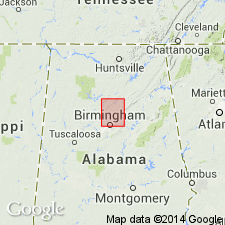
- Usage in publication:
-
- Parkwood formation*
- Modifications:
-
- Named
- Dominant lithology:
-
- Shale
- Sandstone
- AAPG geologic province:
-
- Appalachian basin
Summary:
Named the Parkwood formation for Parkwood, Jefferson Co., AL. Unit is mainly gray or greenish sandy shale and sandstone (no calcareous beds). Thickness ranges from a feather edge to 2000 feet. The Parkwood overlies the Pennington shale and unconformably underlies the Brock coal bed, basal bed of the Pottsville formation. Unit is of Mississippian age (upper 500 feet may be of Pennsylvanian age).
Source: GNU records (USGS DDS-6; Reston GNULEX).
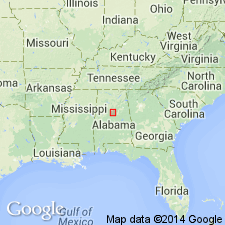
- Usage in publication:
-
- Parkwood Formation*
- Modifications:
-
- Biostratigraphic dating
- AAPG geologic province:
-
- Appalachian basin
Summary:
Miospore and plant megafossil assemblages indicate that the Parkwood Formation of the Warrior, Cahaba, and Coosa coal fields of Alabama is of Late Mississippian and Early (but not earliest) Pennsylvanian age. The lower part of the Parkwood correlates with the Bluestone Formation at the Pennsylvanian stratotype in West Virginia.
Source: GNU records (USGS DDS-6; Reston GNULEX).
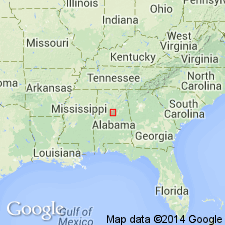
- Usage in publication:
-
- Parkwood Formation
- Modifications:
-
- Overview
- AAPG geologic province:
-
- Black Warrior basin
Summary:
Parkwood Formation is a cyclic succession of alternating units of mudstone and sandstone and is thickest in the Cahaba synclinorium. Thickness there ranges from less than 425 m at the northeastern end to about 760 m in the southwest. Fine-grained, argillaceous, micaceous sandstone composes 15 to 20 percent of the formation. Sandstone beds reach 20 m in thickness. Cross-bedding and ripple lamination are common. Gray mudstone intervals between the sandstones contain siderite nodules and thin beds of clayey coal. Depositional environment is interpreted as a fluvial-dominated deltaic system. Eight depositional facies have been recognized: distributary channel, distributary mouth bar, distal bar, prodelta, open marine, crevasse splay, marsh, and interdistributary bay. Evaluation of these facies and northeastward decrease in thickness of the formation indicate dispersal of Parkwood sediments to the northeast, though sufficient paleocurrent data are lacking to prove this interpretation.
Source: GNU records (USGS DDS-6; Reston GNULEX).
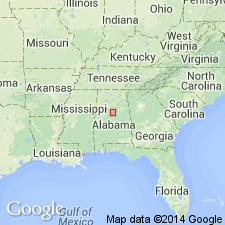
- Usage in publication:
-
- Parkwood Formation
- Modifications:
-
- Overview
- AAPG geologic province:
-
- Black Warrior basin
Summary:
A very thin extensive tongue of the middle Bangor Limestone in the Black Warrior basin, informally called the Millerella limestone, separates the Parkwood Formation into upper and lower units. The sandstones and mudstones of the lower part of the Parkwood overlap the lower tongue of the Bangor Limestone toward the northeast. The upper mudstones and sandstones of the Parkwood, which contain several thin tongues of limestone, grade northeastward into the upper part of the Bangor Limestone. The Mississippian-Pennsylvanian boundary is within the Parkwood above the Millerella.
Source: GNU records (USGS DDS-6; Reston GNULEX).
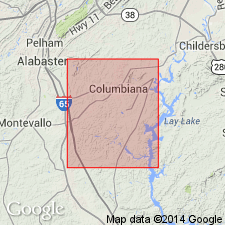
- Usage in publication:
-
- Parkwood Formation
- Modifications:
-
- Revised
- AAPG geologic province:
-
- Appalachian basin
Summary:
Most of the rocks mapped as Parkwood in this study were mapped as Floyd Shale by Butts (1940). Abundant sandstone is present in all outcrops. Detailed mapping has led to the subdivision of the formation into three informal members: the lower member, the quartz arenite member, and the upper member. Subdivisions are most easily recognized in the Elliotsville thrust sheet. A total thickness of 2,179 ft has been calculated in this area. Thickness in the Dry Creek-Yellowleaf thrust sheet exceeds 5,960 ft, but the three members are more difficult to distinguish. Lower member consists of interlayered medium- to dark-gray micaceous shale and siltstone and thin-bedded fine-grained micaceous sandstone. Shale comprised up to 90 percent of most outcrops. Thickness of the lower member ranges from 1,391 ft to 1,870 ft. The quartz arenite member is the most conspicuous unit. Consists of fine- to medium-grained, thin- to medium-bedded sandstone, locally interlayered with medium-gray micaceous shale. This middle member reaches 400 ft in thickness in the Elliotsville thrust sheet and exceeds 1,000 ft in the Kelley Mountain window. The upper member is similar to the lower member and is dominated by medium- to dark-gray micaceous shale interlayered with thin-bedded sandstone and siltstone. Member is 384 ft thick in the Elliotsville thrust sheet and exceeds 1,550 ft to the southeast. No fossils were recovered from the Parkwood during the course of this study, but Late Mississippian to Early Pennsylvanian age for the unit is based on faunal assemblages found to the north.
Source: GNU records (USGS DDS-6; Reston GNULEX).
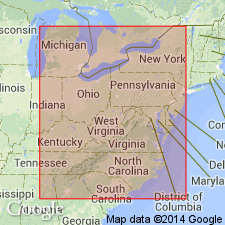
- Usage in publication:
-
- Parkwood Formation*
- Modifications:
-
- Areal extent
- AAPG geologic province:
-
- Appalachian basin
Summary:
A source for siliciclastic sediments of southern Appalachian basin lies to the south, beneath coastal plain of AL and MS, and to the west off the edge of buried carbonate platform in MS and AR. From this source, shales and turbidite sequences of Floyd and Parkwood Formations spread northeastward into AL and southernmost TN, grading into orthoquartzites, graywacke sandstones, and conglomerates.
Source: GNU records (USGS DDS-6; Reston GNULEX).
For more information, please contact Nancy Stamm, Geologic Names Committee Secretary.
Asterisk (*) indicates published by U.S. Geological Survey authors.
"No current usage" (†) implies that a name has been abandoned or has fallen into disuse. Former usage and, if known, replacement name given in parentheses ( ).
Slash (/) indicates name conflicts with nomenclatural guidelines (CSN, 1933; ACSN, 1961, 1970; NACSN, 1983, 2005, 2021). May be explained within brackets ([ ]).

